| dc.description.abstract | Background A higher sense of mastery of doctors’ clinical work could benefit not only their own mental health but also their work performance and patient care. However, we know little about factors associated with perceived mastery of clinical work among physicians. Our aim was therefore to study characteristics of those with stable low levels and of those with increased levels of mastery over a period of ten years of medical practice. Methods N = 631 doctors were surveyed in their final year of medical school in 1993/94 (T1) and 10 (T2), 15 (T3) and 20 (T4) years later. Low and increased perceived mastery of clinical work were measured between T2, T3 and T4. Response rates for all items measuring low and increased mastery were 238/522 (46%) and 256/522 (49%) respectively. The following explanatory variables were included: demographics, medical school factors, personality and contextual work-related and non-work-related factors. Results N = 73 (31%) of the doctors reported stable low mastery from T2 to T4. The following variables were significantly associated with low mastery in the adjusted analyses: vulnerability (OR: 1.30, P < .000, CI: 1.12 to 1.50), drinking alcohol to cope with stress during medical school (OR: 2.66, P = .04, CI: 1.03 to 6.85) and social support (OR: 0.78, P = .002, CI: 0.66 to 0.91). N = 39 (15%) reported increased mastery during the ten-year period from T2 to T4. Perceived job demands (OR: 0.66, P = .02, CI: 0.45 to 0.98) and taking up a leading position (OR: 3.04, P = .01, CI: 1.31 to 7.07) were associated with increased mastery after adjustment. Conclusions Stable low sense of mastery over time is associated with having a vulnerable personality, a history of having used alcohol to cope with stress during medical school and lack of contemporary social support. Conversely, increased sense of mastery is associated with taking up a leading position and having the perception that job demands are decreasing over time. These findings indicate that perceived mastery of clinical work may not be a trait, but a state modifiable over time | |
